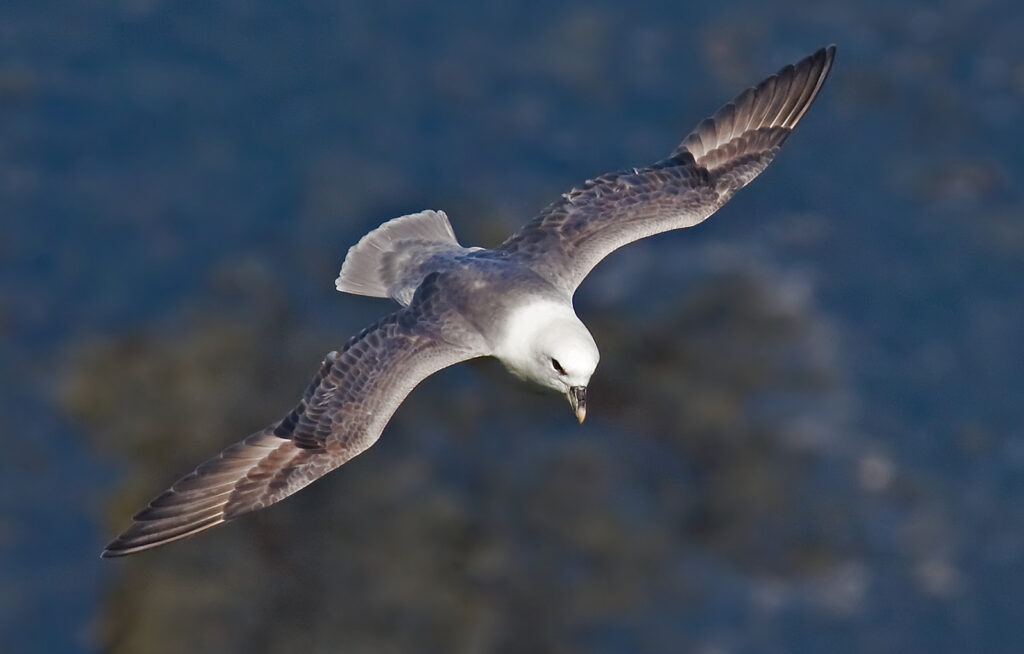Just returned from a cruise on the North Atlantic. There are a number of seabirds nesting on cliffs during the short summer season such as murres, guillemots, gulls, kittwakes, and the colorful Atlantic Puffin. But getting away from the shoreline and traversing the open ocean there are fewer but perhaps more interesting birds like shearwaters, petrels, and the fulmar. Many fulmars. Seeming to be of endless energy, fulmars followed our ship endlessly, hoping that the propellors churn up some food for them or, I surmise, hope that the passengers or crew throw some food overboard for them. Here’s a video

Looking a lot like a gull, the fulmar is actually a tubenose of the order Procelliformes, family Procellaridae, along with shearwaters, petrels, and albatrosses. In flight they fly with a stiff-winged flapping and if you can get a good look, their shorter head and tubenose are defining characters. The name comes from the Old Norse Fúlmár meaning “foul-gull” because of the birds’ vomiting a foul-smelling liquid that is produced and stored in their proventriculus, an expansion of the esophagus. The waxy liquid is used to feed the one or two chicks they produce and also as a defense against predators. It is said that this waxy liquid may so mat down the plumage of a predator that it will result in its inability to fly and eventual death.
Members of the order Procellariiformes have a strong sense of smell, being able to detect dimethyl sulfide released from plankton in the ocean which helps to locate prey at sea
Procellariiforms drink seawater, so they have to excrete excess salt. They have an enlarged nasal gland at the base of the bill above the eye and this salt gland removes salt from the system, forming a 5 percent saline solution that drips out of the nostrils.
Both species of fulmar are similar in appearance with a bright white belly, light gray dorsal side, and black or speckled wingtips.
The Northern Fulmar (Fulmarus glacialis) are found primarily in subarctic regions of the North Atlantic and North Pacific oceans. They breed in the Arctic regions of the North Atlantic and in eastern Siberia and the Alaskan Peninsula. Northern populations usually migrate south when the sea is frozen but spend most of their life on the open ocean. They breed on rocky cliffs and islands and sometimes nest on houses along the sea coast. The Southern Fulmar (F. glacialoides) nests in the Southern Hemisphere around the edges of the Antarctic.
Fulmars will eat anything in the ocean or on the shore, including carrion. They have well-developed nasal organs and can detect smells up to 20 miles away. Most likely they are smelling dimethyl sulfide, a volatile substance produced by plankton. What fascinated me, watching these birds over 1000 miles of ocean, is that I never saw one sitting on the water, no matter how calm the seas, The birds flew just over the waves or the flat ocean, occasionally participating in dynamic soaring, but mostly right above the water. Just plain fulsome.
What a lovely description of your adventures at sea and interaction with so many birds! It was truly educational.! Thank you for sharing it here.
Amazing that the fulmar can detect smells up to 20 miles away!
Sounds like a lovely cruise. Thank you for sharing your insights and joys with us.
Alice
Really enjoyed your sharing. Hope to do a pelagic birding day off Plymouth in October.
Googled to find that “the average surface salinity of seawater is 3.5%,” so interesting to know the fulmer can excrete 5%.
Question about barn swallow chicks: Yesterday I watched as 2 of 3 barn swallow chicks – nearly fully fledged, intercepted every bug being flown in by a parent. The 3rd smaller chick just sat passively behind them. Assuming he’s not ill, will he have a chance of being fed (surviving) after the other two leave the nest? .
We.ll, seabirds eat fish and squid and such whose bodies are high in salt so between food and water, their intake is at least 5%..
Regarding the swallows, yes, he/she will have a chance but who knows?
Thank you for your formative posts. The current one on Fulmars filled the gap in my knowledge of sea birds. If I may ask a question about hummingbirds, are you aware of Hummingbirds engaging in “anting”?
I saw a female Ruby throated hummingbird on some pavers with her wings outstretched. She was injured from colliding with a window. Except for the fact that the maxillary portion of her bill being cracked and the fact that she was stunned, she seemed to be okay. I managed to feed her some sugar water and she flew off. There were several Chipping sparrows hunting insects on the pavers near the Hummingbird. Could it be that the Hummingbird had her wings out to make her seem larger in order toward off predators?
Never observed hummingbirds anting but I wouldn’t be surprized.As far as wing spreading, it’s mostly for balance. Sick or injured birds do that as they can’t perch or walk well in their condition.